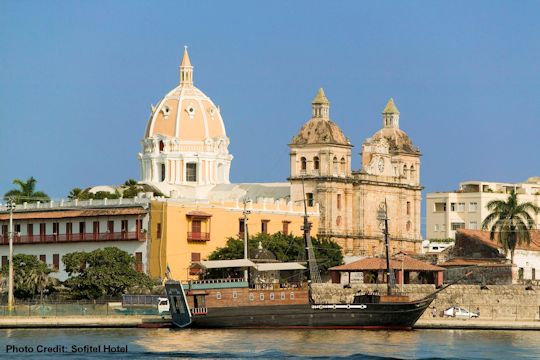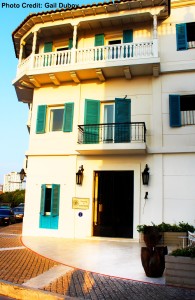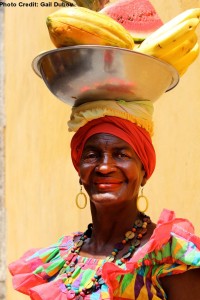Once off tourism radar, Cartagena de Indias, Colombia’s charming colonial city and busy seaport, is now back in the crosshairs of a tourist boom. Cobblestone streets echo with the sound of horse-drawn carriages. Waiters at the many outdoor cafes are busy serving rounds of cold Club Colombia beer. Salsa music moves through the air raising the energy level just a bit higher on lazy, hot, humid days. Construction workers put finishing touches on one of the many restored centuries-old colonial houses, freshly painted a saturated pink, it’s huge wooden Spanish door standing as a proud testament to the city’s historic past. Cartagena, on the northwest coast of Colombia, has reinvented itself as a new tourist hot spot with glorious colonial architecture, luxury hotels, sophisticated restaurants and international boutiques.
A decade ago, Colombia was anything but a mainstream travel destination. Leftist rebels were in control and the only tourism industry consisted of backpackers and thrill seekers, as a former U.S. Ambassador to the country once put it. But in 2002 everything began to change. Former President Alvaro Uribe Velez was sworn into office and began a security and defense policy that won back control of the country and jumpstarted the growth of Colombia’s tourism sector. The dark days of fear were over but then came the tough part—shifting the world’s perceptions of the country. A widespread national branding campaign began in 2006, promoting its beauty and its safety. Commercials featuring Colombian celebrities like Shakira were broadcast throughout the U.S. The campaign worked big time.
Today, with more than 30 percent of its workforce involved in the tourism industry in one way or another, Cartagena, a charming Caribbean city of 1.4 million, is reaping the rewards of the savvy nation branding campaign, tax incentives and improved security. In contrast to just a few years ago, foreign tourists arriving by planes and cruise ships now flock to Cartagena’s seven miles of walls and the towering San Felipe fortress. These relics look much as they did in the 17th-century when the Spanish built them to protect ships taking silver, gold and emeralds from the New World to Spain. It’s now the country’s fastest growing city, with tourism statistics that are staggering. Its culture, architecture and white-sand beaches have turned Cartagena, a UNESCO-protected colonial city, into Colombia’s tourism gem, as precious as its gold and emeralds in rebuilding its tourist economy.
According to the Corporation de Turismo Cartagena, foreign tourism grew 15.9 percent in 2012, twice the national rate, welcoming 207,000 international visitors. The 2013 cruise season will bring an estimated 313,000 passengers to Cartagena, an increase of 16 percent over last year. The upcoming season welcomes new cruise lines like Kristina Cruises, Paul Gauguin Cruises and the return of Disney cruises, who has not visited the port since 2008. The cruise line with the highest participation will be Princess Cruises with 39 scheduled arrivals and close to 77,000 passengers. Meanwhile, other cruise lines will increase their number of arrivals in Cartagena: Royal Caribbean, Celebrity, Holland America and Norwegian Cruise Lines. According to the Cartagena Port Society General Manager, “the arrival of the new cruise lines reflects Colombia’s ranking as a tourist destination and consolidates Cartagena as a paramount city for the cruise line industry.”
Shortly after the country’s new branding campaign took off, it turned its attention to the lack of hotel rooms. A new law exempting new hotel development from income taxes for 20 years seems to have worked. Major hotels with a presence in the city include Hilton, Holiday Inn, Hotel Dann, Hotel Caribe and Sonesta—all outside the walled city. The Four Seasons will open a new luxury hotel in Getsemani, the district adjacent to the old city, in the next two years. In early 2013, InterContinental, Sheraton, Radisson, Iberostar, Marriott, Hyatt and Melia Hotels all had properties either in final planning stages or under construction.
Inside the walled city the luxury Sofitel Legend Santa Clara is the grand dame of restored historic sites, once a 17th-century convent, now a Legend-category five-star property. With 123 rooms, including 19 suites, the hotel boasts a 1539 square foot Botero Suite, named for the celebrated Colombian artist. Built around a colonial courtyard with tropical gardens, the hotel has a state of the art spa, pool and resident toucan who hops to your table to greet you in the morning.
The Charleston Santa Teresa, once home to a Carmelite order, is another restored convent occupying a full city block with large interior courtyard and rooftop pool with spectacular views.
Within the walled city dozens of stylish boutique properties have been converted from colonial buildings, all with fifty rooms or less. The lovingly restored boutique hotel Bovedas de Santa Clara is across from the city wall and the luxury Sofitel Santa Clara, whose facilities are available to Bovedas guests. It has eighteen rooms; eight duplex suites and ten luxury rooms. Promotion of tourism is under the auspices of Proexport Colombia, the government-run agency which estimates that Cartagena will add 2,500 hotel rooms to its existing stock of 5,500 by 2014.
EXPLORING CARTAGENA
The best way to see old Cartagena is to stroll through the city’s maze of cobbled alleys, where enormous balconies are shrouded in bougainvillea and colonial churches dominate the city’s leafy plazas. The largest, The Cathedral, started in 1575 and partially destroyed by the cannons of the pirate Francis Drake, has a domed tower that rises above the old city. The Iglesia de Santa Domingo is the oldest in the city with massive buttresses that were added to prevent the church from collapse, due to the miscalculation of a 16th-century engineer. But the most romantic is the 16th-century Church of San Pedro Claver. On any evening near sunset the church is alive with wedding preparation and filled with guests in finely pressed white linen attire or formal wear.
The Castillo de San Felipe de Barajas is the largest and strongest fort built by the Spaniards in their colonies. Constructed between 1639-1657 on top of a hill overlooking the city, it was never taken, despite many attempts. Its complex underground tunnel system is partially open to visitors—a walk not to be missed. The Convento de La Popa sits atop the highest point in the city, with a chapel and charming flower-filled courtyard. Views from its patio are spectacular. The Palacio de la Inquisicion is perhaps the finest building in the city with its late colonial architecture and notable long balconies along its facade. Once the seat of the Punishment Tribunal of the Holy Office—where heretics were found guilty for crimes of magic, witchcraft and blasphemy—it is now a museum not for the faint of heart. Rusty old instruments of torture are displayed along with historical objects from colonial times. The Museo del Oro y Arqueologia (The Cartagena Gold Museum) has an extensive collection of gold and pottery of the Sinu Indians who inhabited the region before the Spanish conquest.
Cartagena features a rich culinary palate, combining flavors and ingredients from the Caribbean, Europe, Africa and even Asia. Whether it’s a typical local street food snack of arepas de huevo (fried corn dough with an egg inside) or prawns in tamarind coconut sauce at one of Cartagena’s many sophisticated restaurants, this is a city that knows good food. Head for El Portal de los Dulces, where a row of confectionery stands on Plaza de los Coches offers local sweets or end your meal with La Envidia, a decadent mango mousse with a tangy grape sauce.
City tours in a Chiva—a colorful traditional bus with lively local music—is a spirited way to explore the city. Four-hour tours include stops at the main tourist sights. If your client wants a break from sightseeing and shopping, suggest a day trip to the beautiful Islas del Rosario. Just 45 minutes by speedboat southwest of the city, this archipelago consists of 27 small coral islands where the color of the sea is a brilliant turquoise. The entire area has been designated a national park where water sports are popular. The peaceful, laid-back 17-room Hotel San Pedro de Majagua on tropical Isla Grande stands in sharp contrast with the energy of nearby Cartagena. It’s got a low key beach vibe with well-appointed rooms and fine local food. The Azul Profundo Package offers two nights at the Bovedas de Santa Clara Hotel, a boutique hotel in Cartagena’s walled city, and one night on the island.
Whether a day tour of the city, a day trip to the islands or travel throughout Colombia, Viventura specializes in culturally authentic experiences with small group tours throughout South America. Founded in 2001, it has offices in Germany, Peru and as of 2011, a U.S. base in Tampa, Florida. The company’s employees live and work throughout nine South American countries, and will customize any tour to fit a client’s needs. Its “Pearl of the Caribbean” Cartagena tour is a bestseller. The five-day tour includes visits to the highlights of Cartagena and a dinner at the city’s most famous restaurant, La Vitrola, known for great food and live music. A day at the beach is scheduled on day three as clients are whisked off in a speedboat for a 45-minute ride to the coral islands of Islas del Rosario and their clear, turquoise water. The day includes lunch, welcome drinks, a trip to an aquarium and snorkeling. A Chiva bus tour through the city the following night ends at Club Havana. A wild night of salsa dancing, Cuban music and tropical drinks await. A Viventura guide is always there to make sure you get on your bus back to the hotel! If your client wants more beach time, Viventura has a seven-day “Colors of the Sea” tour visiting three Caribbean islands after two full days in Cartagena. The tour company’s “Coast to Capital” tour visits Cartagena, followed by the Rosario Islands, the beautiful Tayrona National Park and ends in historic Bogota.
“Viventura doesn’t offer tours, it offers experiences,” explains its founder, CEO Andre Kiwitz. “Our travelers don’t just want a sightseeing experience, they want to live it. Our itineraries are arranged to give them that in-depth exploration they desire.”
Viventura’s motto, “Popular Places, Local Faces,” puts clients in touch with locals—whether it’s a visit to a nearby market or dinner with a local family. The company offers more than 25 full itineraries including “Treasures of Colombia,” an eleven-day tour where salsa dance lessons are taught at a local recreation center, coffee tastings are arranged at a local coffee plantation, river rafting, rappelling down a waterfall or dipping in healing mud from a nearby volcano are all part of this spirited program. Kiwitz added, “We focus on what we know and love—South America. That passion makes us the South America specialists offering the most culturally authentic tours you’ll find.” Tours start at $899/pp.
Cartagena is an hour’s flight from Bogota and just two and a half hours from Miami. As of November 2012, JetBlue offers the only nonstop service on their Airbus A320 fleet from New York to Cartagena’s Rafael Nunez International Airport. Flights leave three times a week on Tuesdays, Fridays and Sundays. Cartagena is JetBlue’s second destination in Colombia and its third route to the country. It currently has daily flights from Fort Lauderdale to Bogota and Orlando to Bogota, offering service to Colombia since 2009. “Cartagena is a place we’ve long had our eye on,” said John Checketts, director of route planning for JetBlue Airways. “It’s one of the most amazing destinations in the Caribbean, a UNESCO World Heritage Site with unparalleled beauty, and a perfect combination of history, beaches and culture.”
Spirit Airlines also flies to Cartagena with connections through Fort Lauderdale. United operates a codeshare with Avianca. USAir, LAN, Copa and TACA also fly from the U.S.
Bovedas de Santa Clara: reservas@bovedasdesantaclara.com
JetBlue Airways: 800-538-2583;www.jetblue.com
Sofitel Legend Santa Clara Cartagena: 800-763-4835; www.sofitel.com
Viventura: 888-238 1602; www.viventura.com;



